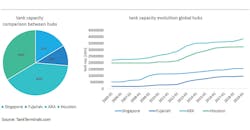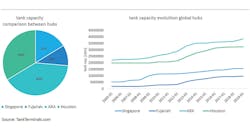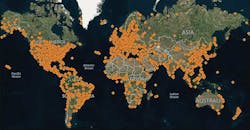Changing markets, importance in global trade flow growing demand for tank terminals, now and into the future, expert says
PATRICK Kulsen, managing director at PJK International, provided a global overview of storage terminal markets, including business drivers and current demand, in the session “Global Overview of Tank Storage Markets” during the International Liquid Terminals Association’s 39th annual International Operating Conference.
The session touched on the changing global markets for crude oil, petroleum products and chemicals, which are causing trade flows to evolve as well, and highlighted the importance of tank terminals in facilitating shifts in global trade. Discussion included where growth is occurring, and where it’s likely to continue.
PJK recently joined with Downstream and TankTerminals.com to form Insights Global, an independent market research company specializing in international petroleum and petrochemical industries whose products include Rhine/ARA barge freight rates, ARA oil product stocks and the extensive TankTerminals tank database.
TankTerminals launched in April 2018 in an upgrade of an online application with new technology, new data and new features, including market share analysis, summary statistics, infrastructure benchmarking of terminals, tank availability, tank capacity evolution and projection, and logistical performance benchmarking.
The following is a summary of the market slides presented during the ILTA international session.
Global overview
PJK says Chinese national oil companies, like the Sinopec Group, are the biggest players in the global tank terminal operators segment. Vopak is the largest independent terminal operator, and the US has a large number of midstream operators, like Magellan Midstream Partners, that, combined, rival the Chinese in tank capacity.
And tank terminal capacity is expanding, which signals a favorable business environment, especially in China, and the European, US and Middle East trading hubs, where PJK says investments are significant. The company estimated 190 terminals were under expansion globally as of June, and another 49 were under construction.
Of the global terminal expansions, 28 were in China and 21 in Houston, and the Middle East had the most new terminals going up with 10.
Regional hubs
PJK identified Houston, ARA (Amsterdam, Rotterdam and Antwerp), UAE (United Arab Emirates) and Singapore as the top regional hubs in global petroleum trading because they house a large number of tank terminals to facilitate activity.
The Houston area, including Beaumont, is the primary hub in North America. It’s a well-integrated refinery and petrochemical production region and a port used to export crude oil, natural gas liquids (NGLs) and liquified natural gas (LNG).
The ARA region, with Rotterdam being the largest port in the area, is the main gateway to Europe due to its connection to the Rhine river. It’s a critical refining and petrochemicals production region, and it is well-integrated with Germany’s chemical clusters. Furthermore, it’s the third-largest bunker port globally.
Fujairah, which is located outside the Strait of Hormuz, is considered part of the UAE region. It’s well-regarded as a safe haven just outside the Arabian, or Persian, Gulf, making it the region’s main physical trade hub, and the second-largest bunker port globally.
Singapore’s strategic location along the main trade route from China to the West makes it a trading powerhouse, PJK said. Along with southern Malaysia, and nearby Indonesian islands, this hub houses many refineries and petrochemical plants—and it’s the largest bunker hub globally.
ARA and Houston are the largest in terms of tank capacity, followed by Singapore and Fujairah. All hubs show a similar growth trend, albeit starting at different moments in time, PJK said.
Business drivers
Tank terminals have various functions, including as a logistics/hub, trading platform and strategic storage, but commercial clients’ operational requirements generally lead them to focus on the logistics and trading functions.
Logistics uses include make/break bulk, distribution and intermodality, integration with an industrial complex, and buffer stocking. Trade uses include physical arbitrage, blending, contango storage and optionality.
Depending on a company’s business view, and whether it prioritizes minimizing costs or maximizing profits, its operational requirements may vary. A cost-centric approach emphasizes smooth operations and service levels, creating what PJK calls a “stable but low-value business,” and a profit-centric approach focuses more on opportunities through responsiveness and optionality, creating a “dynamic but high-value business.”
Traders make money by taking physical (and paper) positions, and buying low and selling high. Strategies for profiting from trading physical commodities include arbitrage (geographical, time and technical); speculation, where traders take a position in anticipation of a move in prices and/or spreads; and optionality, which gives traders the flexibility to profit from market opportunities and limit losses if the market turns against their position.
Demand indicators
Factors that provide an indication of activity in tank storage markets include oil price levels, volatility, forward curves, stock levels and arbitrage.
Currently, PJK said, oil prices are moderate and show above-average volatility, which is good for oil trading. But the forward curve is in backwardation, which occurs when the current price of an underlying asset is higher than prices trading in the futures market, and this factor is weighing on tank storage demand.
And looking at the forecasted balance between supply and demand, PJK said it doesn’t see this condition changing anytime soon either. Backwardation has been causing oil stock levels to decrease since 2016.
However, arbitrage results in greater trade flow, which has been rising globally, PJK said, structurally supporting tank storage demand, and tank capacity and trade flows have been tracking each other for the last 10 years.
Conclusion
Considering all the market factors, PJK says tank terminal demand is strong.
Rises in volatility and trade flows ensure the terminal business is a structurally growing business, and sooner or later an event will trigger the forward curve to go to contango, which will increase utilization rates and support storage rates.
Visit insights-global.com or email Kulsen at [email protected] for more information.
About the Author
Jason McDaniel
Jason McDaniel, based in the Houston TX area, has more than 20 years of experience as an award-winning journalist. He spent 15 writing and editing for daily newspapers, including the Houston Chronicle, and began covering the commercial vehicle industry in 2018. He was named editor of Bulk Transporter and Refrigerated Transporter magazines in July 2020.




